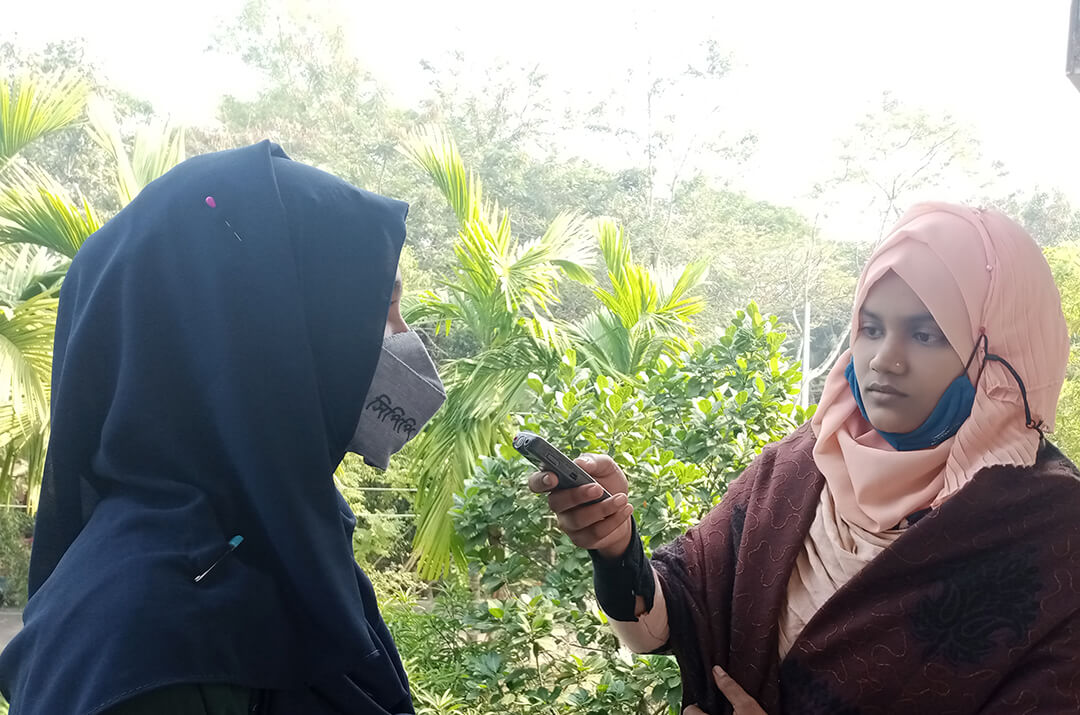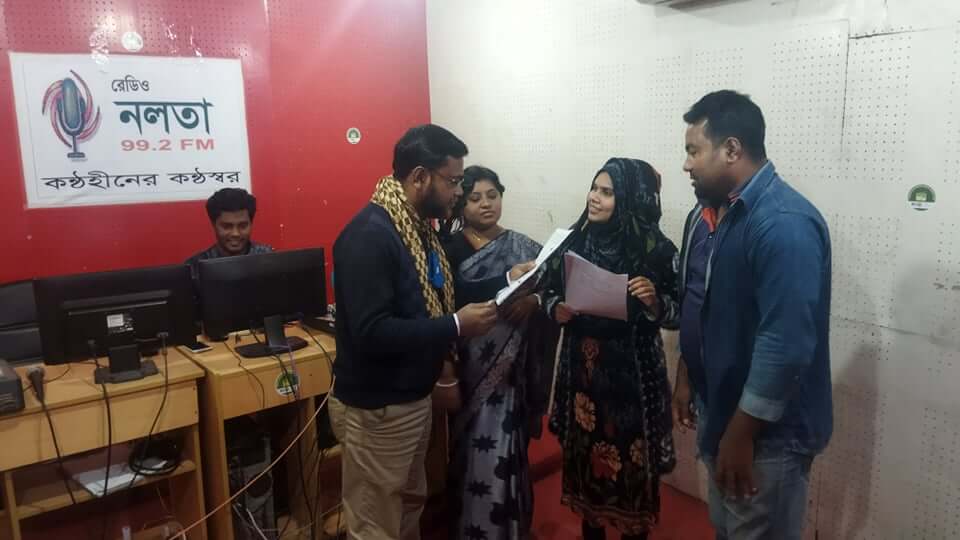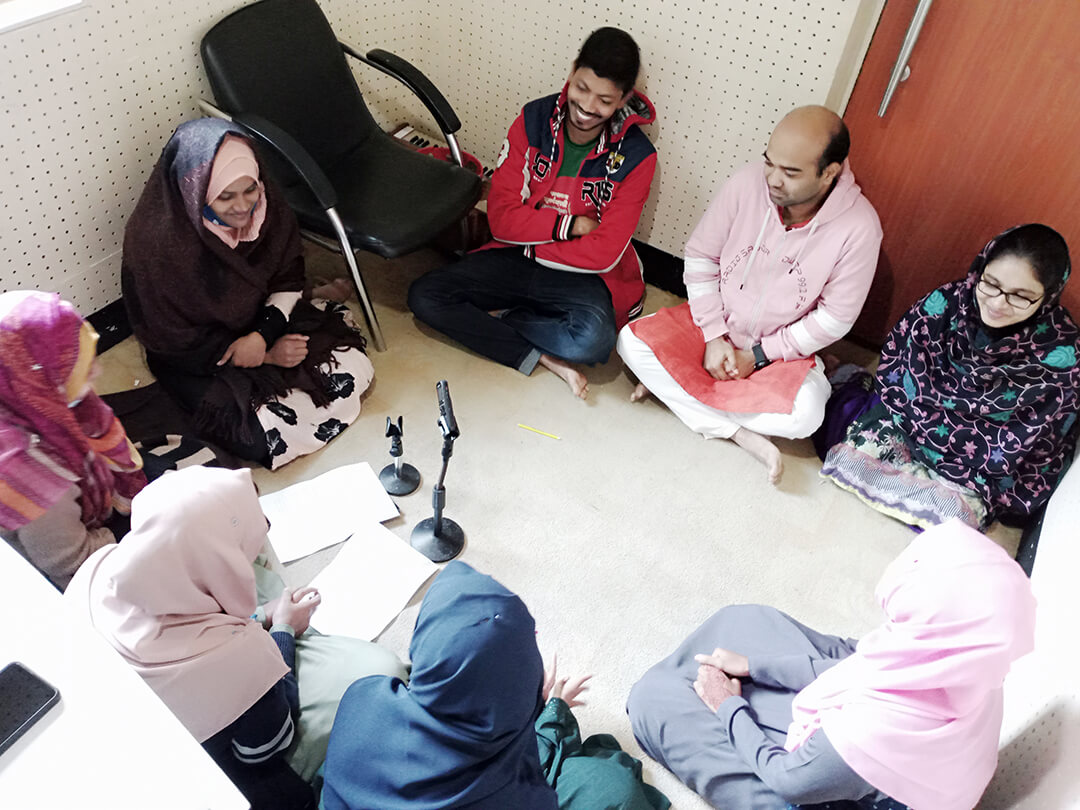Executive Summary
BNNRC started an awareness campaign title “Ending Violence against Women (VAW) through Access to Justice” through 16 community radios in Bangladesh. It was revealed that the rate of violence against children, girls and women has been increased rapidly since March 2020 due to COVID which hampered the family bondage too. According to media reports, 4,249 women and 456 children have been victimized in the month of April 2020 in 28 districts of Bangladesh. Besides, the rate of contamination is increasing day by day. Considering the situation, it is difficult to predict when the situation will be under control. In general, the project aims to bring women, children, and all other inhabitants under the same umbrella to protect themselves from abasement; no matter how privileged or not they are in general. The aim is to raise awareness for the maximum number of rural community people to use National Helpline Numbers along with information on support provided by the government and other non-government organizations to defend / dissent violence in any form against women and child rights.
The objective is to raise awareness for the maximum number of rural community people (the radio listeners in the national and district level) to use helpline numbers along with information on support provided by the government and other non-government organizations to defend / dissent violence in any form against women and child rights.
Geographic Region
Community Radios reach programs in 16 districts, covering 7 divisional geographic regions namely Rangpur, Rajshahi, Khulna, Barisal, Dhaka, Sylhet and Chattogram in Bangladesh. Literacy rates, culture, dialect, ritual norms, profession and fashion of communication of these regions are different but the need is similar and almost the same. This project was designed to address the need of all seven regions and its communities to reduce violence against children, girls and women.
Target Beneficiaries’ Group(s)
The project aims to make of the women aware about access to justice for reducing the violence caused by specially COVID -19. The radio stations are reaching approximately 10 million of people through this campaign program. The target of the project is the whole community, particularly, the marginalized communities.
Partnership
Since 2020, BNNRC has been providing support to the community radios in capacity building of the broadcasters and station management on addressing COVID -19 pandemic. 16 Community Radios (CR) are participating in the project implementation located in 16 different locations in Bangladesh. The name, location and e-mail address of the radio stations are –
- Community Radio Padma 99.2FM, Monafer Morh, Rajshahi
Email: radiopadma@gmail.com
- Community Radio Nalta 99.2FM, Kaligonj, Satkhira
Email: info_radionalta@naltahospital.org.bd
- Community Radio Lokobetar 99.2FM, Barguna Sadar, Barguna
Email: lokobetar@gmail.com
- Community Radio Pollikontho 99.2FM, Matarkapon, Moulvibazar
Email: pollikontho@gmail.com
- Community Radio Sagor Giri 99.2FM, Sitakunda, Chattogram
Email: sagorgiri@gmail.com
- Community Radio Mahananda 98.8FM , Belepukur, Chapai Nawabgonj
Email: sm@radiomahananda.fm
- Community Radio Mukti 99.2FM, Maloti Nagar, Bogura
Email: news.rmfm.bd@gmail.com
- Community Radio Chilmari 99.2FM, Chilmari, Kurigram
Email: radiochilmari@gmail.com
- Community Radio Jhenuk 99.2FM, Pabahati, Jhenaidah
Email: radiojhenuk@gmail.com
- Community Radio Krishi 99.8FM, Amtoli, Barguna
Email: krishiradioais@gmail.com
- Community Radio Naf 99.2FM, Teknaf, Cox’s Bazar
Email: radionaf@gmail.com
- Community Radio Bikrampur 99.2FM, Dewbhogh, Munshigonj
Email: radio@ecbangladesh.org
- Community Radio Meghna 99.0FM, Charfashion, Bhola
Email: info@radiomeghna.net
- Community Radio Sagordwip 99.2FM, Hatiya, Noakhali
Email: radioshagordwip@gmail.com
- Community Radio Sarabela 98.8FM, Radhakrishnapur, Gaibandha
Email: radiosarabela@gmail.com
- Community Radio Boral 99.0FM, Bagha, Rajshahi
Email radioboral.program@gmail.com, sm@radioboral.org
Overview / Background of the Program
The Bangladesh Government’s key national strategy document is the Seventh Five-Year Plan, which identifies the need for comprehensive judicial reform, including improved legal aid and case-processing. The criminal justice system is chronically underfinanced and seen as corrupt. It offers limited legal aid, particularly to vulnerable groups. As a consequence, many pre-trial detainees spend long periods of time in prison waiting for their cases to be resolved. The level of overcrowding in many prisons is beyond 200%. As Justice Audit findings show one reason for this is that too many cases unnecessarily end up in the formal criminal justice system because people are not fully aware of alternatives to the formal system, such as village courts or mediation services. Prisoners also lack access to rehabilitation and reintegration services.
The Government of Bangladesh (GoB) has taken steps in recent years to reform the judiciary and prison system. In some regions, successful moves have been made to promote access to formal justice as well as to alternative dispute resolution mechanisms. These include equal access to restorative justice (RJ), improved inter-institutional cooperation (e.g. inter-ministerial committee and district case coordination committees), improving access to justice for disadvantaged groups (through paralegals) and the introduction of rehabilitation as a part of the penal system.
Project Duration
January 01, 2021 to December 31, 2021
Project Goal
The project aims to create a common platform by bringing women, children, and all other inhabitants under the same umbrella to protect themselves from abasement; no matter how privileged or not they are in general.
Objectives
The campaign `Khola Janala’ (allegorically named ‘Open Window’); signifies looking to the easily accessible vast opportunities through the open window – has emphasized the three thematic areas
- Access to justice through Legal Aid,
- Violence against women including support for domestic violence (DV) survivors,
- Impact on adolescents (especially, girls in isolation) during COVID-19.
The radio stations developed and broadcasted a total of 48 radio magazine programs (3 Magazine x 16 Radio Stations) in local dialects in the country.
The specific objectives of the Campaign are –
- to aware people including the rural community with information on national and district level helpline numbers along with information on support for violence against women and gender-based violence issues
- to increase community access to legal aid services provided by the government and other non-government organizations to improve their situation
Achievement During the Reporting Period
- Around 1.87 million listeners of the target areas (the coverage area of 16 CR stations in 14 districts of the country) became a level of degree aware of legal – and at the local level.
- Reach out a total of 4790 netizens through the community radio Facebook page.
The programs were streamed live on the radio, radio broadcasters and volunteer’s Facebook page, and the outreach of the campaign is outlined below:
| Sl | Name of CR | Listener of the Programs
(5-10% of total listeners) |
Total | Community Response through FB (Like, comments and views) | Total | ||||
| *EP-1 | EP-2 | EP-3 | EP-1 | EP-2 | EP-3 | ||||
| 01 | Radio Padma | 50, 000 | 45,000 | 55,000 | 150000 | – | – | – | 0 |
| 02 | Radio Nalta | 55,000 | 65,000 | 60,000 | 180,000 | 64 | – | 125 | 189 |
| 03 | Radio Lokobetar | 25,000 | 30,000 | 27,000 | 82000 | 45 | 18 | 23 | 86 |
| 04 | Radio Pollikontho | 40, 000 | 40, 000 | 40, 000 | 120000 | 146 | 108 | 89 | 343 |
| 05 | Radio Sagorgiri | 20,000 | 15,000 | 20,000 | 55000 | 108 | 55 | 57 | 220 |
| 06 | Radio Mahananda | 70,000 | 55,000 | 65,000 | 190000 | 315 | 315 | ||
| 07 | Radio Mukti | 25,000 | 22,000 | 27,000 | 74000 | 297 | 116 | 113 | 526 |
| 08 | Radio Chilmari | 35,000 | 40,000 | 35,000 | 110000 | 450 | 113 | 210 | 773 |
| 09 | Radio Jhenuk | 30, 000 | 30,000 | 27,000 | 87000 | 240 | 174 | — | 414 |
| 10 | Krishi Radio | 10,000 | 20, 000 | 15, 000 | 45000 | – | – | – | 0 |
| 11 | Radio Naf | 70,000 | 70,000 | 80,000 | 220000 | – | – | – | 0 |
| 12 | Radio Birampur | 35,000 | 30,000 | 32,000 | 97000 | 343 | 104 | 103 | 550 |
| 13 | Radio Meghna | 20,000 | 21,000 | 20,000 | 61000 | 166 | 90 | 70 | 326 |
| 14 | Radio Sagordwip | 10,000 | 20, 000 | 15, 000 | 45000 | 59 | 40 | 64 | 163 |
| 15 | Radio Sarabela | 50, 000 | 45,000 | 50,000 | 145000 | 328 | 136 | 132 | 596 |
| 16 | Radio Boral | 70, 000 | 60,000 | 80,000 | 210000 | 123 | 52 | 114 | 289 |
| 1,871,000 | 4,790 | ||||||||
Replicability
The project has a replicable model which can be imitated with a little or no modification according to the situational needs in any country with the same or similar issues by any organization regardless of nationality, religion or economic status of that particular country / nation.
Sustainability
- knowing that there is a way to seek for legal support by making only a quick phone call makes them feeling secured emotionally and physically at the society, workplace, and even at their own home.
- Being the member of the marginal group, when children and women feel safe and secured even if they belong to an oppressive system
- Will constitute a positive active practice of living-thinking-making
- Allows children and women to perform better in their regular studies / responsibilities respectively with greater confidence
- Children will grow up with self-esteem having a better mental health, and consequently can shape their future as well as stepping at as a responsible citizen
WSIS Values Promotion
Through this project, women will be able to contribute for making a peaceful family through equality, tolerance and shared responsibility which will ultimately lead to a peaceful harmonized society.
WSIS Action Lines related to this project
- AL C3. Access to information and knowledge
- AL C5. Building confidence and security in the use of ICTs
- AL C6. Enabling environment
Relevant Sustainable Development Goals (SDGs)
In line with the United Nations SDGs, by increasing the accessibility of information for grass-root people, we can achieve the following objectives:
- Goal 3: Good Health and Well-being
- Goal 4: Quality education
- Goal 5: The initiatives have been contributing to achieving gender equality and empowering all women and girls.
- Goal 8: Decent work and economic growth
- SDG-16.3: The initiative is increasing participation of poor justice seekers in media is an agenda for aiming access to justice for all, reduction of social inequality, and to make easy their access to information.
- SDGs 16.10: The program has been contributing to community access to information by using direct media.
Extended Description
In the backdrop of the current situation and to galvanize action to address violence against women and children at the grassroots level, access to call centres and Helpline numbers is a key measure for ensuring access to justice and redressal. Citizens and persons seeking legal assistance need to be made aware about the services provided by the government, and other local services available at the grassroots level using Community Radio so that information is easily accessible and reaches the most disadvantaged and vulnerable groups of people living in remote areas.
Community Radio is recognized as a means of communication that plays an important role in the process of informing the community and acting as a catalyst in assisting free flow of information. It is a proven and useful tool to reach the most disadvantaged sectors of the society including the poor, women and children. Community Radios are geographically distributed in such a way that they reach out to people of different regions of the country, particularly those who are living in relatively less advantaged locations and in districts considered to be the most vulnerable in terms of socio-economic development. It acts as the mass media for the grassroot-population in providing information and raising awareness on crucial issues in the rural community. At the same time, with the inclusion of core SDG principles into the community radio programs, it helps to facilitate increased services in local communities about the opportunities for economic growth, challenges on environmental protection and social development for improved livelihood of the marginalised community.
Challenges
- Through the campaign, it is comparatively easy to raise awareness among the community people within a short time but it is difficult to measure the use of the learnings and its benefit.
- In some cases, the broadcasters have insufficient knowledge, skills and opportunities to capture and collect the result from the listeners
Recommendations
- To achieve a better result and create a link between duty holders and duty bearers, the program might be in Radio Talks format; where the service providers and experts on the issue will join and discuss (Phone in/ Facebook live) and the community people will get the opportunity to ask their questions and receive answers/service instantly. Also, the beneficiaries may join the radio talks and share their experiences. It may help to create a positive attitude on the existing system of access to justice through Legal Aid.
- A Handbook may be developed for community radio broadcasters which will use as the toolkit for developing radio programs and social media contents maintaining sensitivity and accuracy along with local level services on the issue of VAW, Child Rights and Legal Aid.
Conclusion
The campaign has received a huge number of positive responses from the community people, especially from the community including viewers of the social media after broadcasting every episode.



